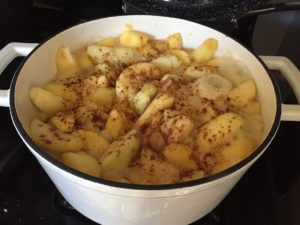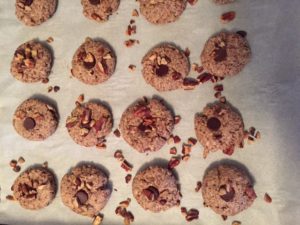Applesauce – A Small Labor of Love
Since we live in an era of instant meals, fast, sugary and over-processed foods, it is good to know that we can walk into any market, and sometimes even food carts or small vendors, and we can always find an apple. Supplied 365 days a year from any of our 50 states that grow the some 2500 different varieties, apples are the third largest fruit crop grown in this country. During the summer months when apples are still growing, we turn to our southern hemisphere neighbors to sell their precious supply of apples to our nation. Honestly, it would be very strange to walk into the produce section of a store and not find a single apple. For even the most basic of markets and stands carry about 2-3 different kinds of apples. The red variety, for those that love the sweet, and the green variety, for those that love a little bit of tartness, and the yellow for a little bit of both. It is amazing how tens of thousands of years have passed since the first apples grew on the mountains of Kazakhstan, that we still cherish this fruit today, eating it plainly whole or sliced, pressing it into a juice or cider, baking it in pies, tarts and muffins, or how I sometimes make it for my family, as applesauce.
As far as I can remember, I have been always been fond of applesauce. Maybe it’s my German heritage that drew me to it. The first recorded recipe, if you will, of applesauce, or apfelmus, happened to be scribed by the Germans. I remember only being able to eat it at home because my parents bought the Costco version of it, which was a jar bigger than me. Yet, when Mott’s came out with the portable cups, I was ecstatic because it meant I could now have one anywhere and anytime! When I was younger, like most kids, I really didn’t care what was in my food, as long as it tasted good. Now that I am much older and have children of my own, I now know to read labels, look for anything relating to “artificial”, “flavorings”, “monosodium glutamate”, and anything else that seems odd or unpronounceable. Even more so I question those same applesauce cups, because I know there is something preserving that applesauce in those little plastic cups. So, I decided a few years back to make my own, and that would be the only way to know exactly what my kids were eating.
The first time I made it was right after a trip to Oak Glen, California, which apples are at the heart of their community. I met a wonderful lady named “Mom” who owned with her family Mom’s Country Orchard. I learned three things that wonderful day. One, it’s important to use many types of apples to get a perfectly rich flavor. Two, making applesauce is easy, and canning it is best because it can last for months and years. Three, if I wanted to grow a tree myself (and I did), the best method was to graft and grow apples on one existing tree. As soon as I got home, I got to work.
Bringing back a half bushel of mixed apples, I went online to find the applesauce recipe and an easy to read method on canning. Finding more than I would ever want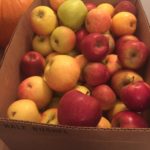 to k
to k
now about canning at the local library, and learning about the history of Ball, Kerr, and Mason jars, I promptly ordered the Kerr jars (they were the least expensive), and the canning supplies. A few days later I washed about 100 apples, cleaned and sterilized all the equipment and started making my applesauce.
I wanted the applesauce to be as organic as possible, so even though some of the recipes I found added butter (weird), brown sugar (more sweet?), or maple syrup (gluttonous!), I decided to leave all of those out and see how it tasted by itself. It took about two hours to peel, core and slice all the apples, and about a cup of lemon juice so the apples wouldn’t turn gross shades of brown on me. I then threw them all in pots on the stove with organic apple cider as the base liquid. I had thought of water, but in the event I screwed something up, I didn’t want to find a watered and drowned apple sauce.
Since canning was new to me, I was a little OCD, and had the jars warming in the oven, and the lids sitting in pots of hot water. To be honest, I have a small kitchen and so it looked like every square inch was a keeper of a pot of something, a bowl of something, or a sink full of something. It’s amazing how much space canning applesauce takes up, so if you are going to try this, make sure you have a good table nearby, empty and clean counters, and lots of bowls and pots to use. Also, I suggest having a few towels, lying around anywhere and everywhere if you need to grab it for cleaning oneself from the mess made during applesauce creation, and possibly to swat your significant other in the rump for sneaking a taste of your untainted and beloved applesauce. When I first made the applesauce, it was over a decade ago, so I didn’t have the original recipe anymore. This last time, when making it with my daughter, I ended up using the recipe below, courtesy of Ree Drummond, otherwise known as The Pioneer Woman, since she explains not only how to make it, but with the least amount of extras in it. I followed her recipe, keeping it simple to just three things that I’ve only ever used in my applesauce: apples, apple cider (for the base) and Pumpkin Pie Spice. That’s it.
For Ree’s recipe, I recommend starting the process based on her instructions of quantity. When I started my first attempt many years ago, I probably believed that since giving birth, I would also be invincible in the kitchen and canning applesauce would be a walk in the park. Additionally, Mom and her adorable fruit stand probably weighed in on my abilities and the simplicity of making applesauce so that yes, I was totally insane to take on the project I did. That said, the recipe for applesauce below is manageable, not very expensive, and you won’t need to remodel your kitchen to accommodate the growing jar population spilling out into another room. This one is easy and I even made notes in italics where I thought her information was lacking details or like all published cooks, she forgot most of us are novices. Make sure you read this entire recipe and the canning information to its completion before you even set foot in a store, farmers stand, or have your plan of attack for your neighbor’s apple tree. The recipe below is simple to follow, but your jars must be ready to go before you plan on canning them. If you don’t want to tackle canning, no judgement. It takes less than an hour to make the applesauce, but it will be about 2-3 hours more with canning. In any case, read on and good luck!
Homemade Applesauce:
Prep Time: 15 Minutes (30 minutes or more for us non-pros)
Cook Time: 25 Minutes
Difficulty: Easy
Ingredients:
• 6 Lbs – Mixed Variety of Apples
• 1 Cup Apple Juice or Cider
• Lemon Juice
• 1 tsp Cinnamon (as an alternative and with less measuring, I used Pumpkin Pie Spice)
• ½ Cup Brown Sugar, Packed (I omitted this)
• Optional Ingredients: Nutmeg, Maple Syrup, Allspice, Butter (I omitted all of these)
Instructions:
1. Peel, Core, Cut Apples into 8 slices (she’s using a tool that cuts and cores, if you don’t have it, don’t worry, just cut them into slices and the smaller the slices the quicker it cooks)
2. Combine all ingredients in a large pot and cook over medium heat, stir occasionally, for 25 minutes (approximately. The apples are done cooking when you can easily mash or cut them with pressure from a spoon.)
Now, here is where Ree and I part ways. She likes her applesauce more like smooth baby food and I like mine with chunks of apples in it. Anyway, here are two options on how to proceed:
3. If you are looking for a baby food version: Carefully puree, after it has cooled, in a food processor or blender.
OR
4. If you ar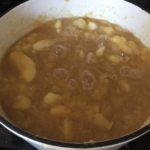 e looking for chunky goodness: While still in the pot, use a potato masher or a fork to mash up chunks of apples. Be as aggressive or sleight of hand as you like, it’s YOUR applesauce.
e looking for chunky goodness: While still in the pot, use a potato masher or a fork to mash up chunks of apples. Be as aggressive or sleight of hand as you like, it’s YOUR applesauce.
Now that your delicious applesauce looks like the inside of a hot and bubbly apple pie, get your jars ready, cause it’s time for a bath! A “canning bath” that is.
This preparation method came from Mama’s Homestead.
Preparing the jars:
1. First, examine your jars for any defects, nicks, cracks, unevenness, etc. This is an important step, any flaws in your canning jars may cause failure in the canning process.
2. If no flaws are are present, wash your jars (old or new) in hot, soapy water and rinse thoroughly, or run them through the dishwasher.
Tip: Do not use anything abrasive on your jars as this may damage the glass.
3. Before filling your jars, they need to be heated (for 10 minutes), so they don’t break during processing. Place jars in a pan with enough water to cover the tops of them. Bring the water to a simmer (180 degrees) on your stove top, keep jars in the simmering water until they are ready to be used. Remove the jars from the simmering water, one at a time, as you are ready to fill them.
Preparing the lids and bands:
1. Inspect them for defects and damage. If the lids are bent anywhere, they will not seal properly.
2. Wash lids and bands in hot, soapy water, then rinse in hot water. Dry Bands. Set lids aside to be heated.
3. Before using your lids, they must be heated for 10 minutes. This helps the lids to seal properly. Place lids in a sauce pan, and fill with water to cover. Heat water to 180 degrees (do not boil). Keep the lids heated until you are ready to use them.
Alright, now I know you listened to me about getting the jars ready before you sliced that first apple. Make sure that your jars and lids are warmed up and ready. Here are the final steps.
Preserving your delicious applesauce:
1. Make sure your large pot has water simmering in it.
2. Place your heated jars next to your workstation and start filling the jars with your applesauce using the funnel about a half inch below the rim.
 3. After you fill them, use a rubber spatula along the insides of each jar to remove air bubbles.
3. After you fill them, use a rubber spatula along the insides of each jar to remove air bubbles.
4. Wipe the tops of the jars off so the lid will create a good seal. Place the lid on top of the jar (centered), then place the ring over it, and tighten it firmly.
5. When you have a batch of jars ready, use the tongs to place them into the pot of simmering water.
6. Turn up the heat and boil the water for 20 minutes.
7. Remove the jars from the pot and after they cool, you’ll hear them pop. Don’t be alarmed, it means you have a nice vacuum seal.
8. If you have more to can, continue repeating the process until you are out of applesauce. Remember to fill the jars up. If you don’t have enough to fill the last jar, treat yourself to some sampling of the good stuff.
9. After they are completely cooled, you can test the lids once more. I took the rings off and pushed a little on the lid, if it sticks shut, you are now an applesauce canning pro!
Though this not a difficult process and for some may seem arduous compared to buying a jar of applesauce from Trader Joe’s, at the end of the day, I wanted to make sure my kids had something good in their bodies. I wanted to begin a tradition of making somethi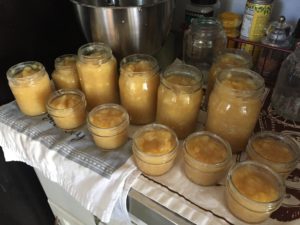 ng from scratch with my kids, of learning how to preserve healthy foods, and to show my daughter (because she is old enough) to appreciate the conveniences we have today – that things weren’t always as easy as picking up something off the shelf. I enjoyed this bonding time with my daughter and I know we will make more yummy foods together. It’s how traditions begin, right?
ng from scratch with my kids, of learning how to preserve healthy foods, and to show my daughter (because she is old enough) to appreciate the conveniences we have today – that things weren’t always as easy as picking up something off the shelf. I enjoyed this bonding time with my daughter and I know we will make more yummy foods together. It’s how traditions begin, right?
References
“9 Strange Facts about the History of Apples.” History Extra. N.p., n.d. Web. 03 Dec. 2016.
“A Brief History of Common Home Canning Jars.” History of the Home Canning Jar and Collecting Mason, Ball and Kerr Jars. N.p., n.d. Web. 28 Nov. 2016.
“Canning Confusion: History of Canning Jars – Prim Mart.” Prim Mart. N.p., 12 June 2015. Web. 27 Nov. 2016.
Drummond, Ree. “Homemade Applesauce.” The Pioneer Woman. N.p., 16 Oct. 2013. Web. 28 Nov. 2016.
“History and Legends of Apples, What’s Cooking America.” What’s Cooking America. N.p., 2016. Web. 27 Nov. 2016.
Jensen, Scott. “A Brief History of Applesauce.” InfoBarrel. N.p., 12 Apr. 2012. Web. 27 Nov. 2016.
“Moms Country Orchards – Oak Glen, Ca.” Moms Country Orchards. N.p., n.d. Web. 28 Nov. 2016.
“Preparing Jars and Lids for Canning – Mama’s Homestead.” Mama’s Homestead. N.p., 16 Dec. 2014. Web. 28 Nov. 2016.
Sharp, Tim. “Apples: Health Benefits, Risks & Nutrition Facts.” LiveScience. Purch, n.d. Web. 28 Nov. 2016.
Synan, Mariel. “All About Apples.” History.com. A&E Television Networks, 13 Sept. 2013. Web. 27 Nov. 2016.

